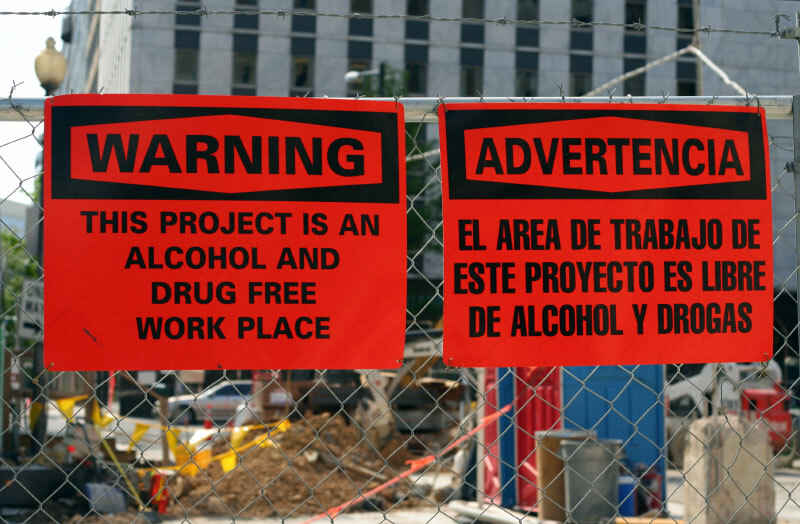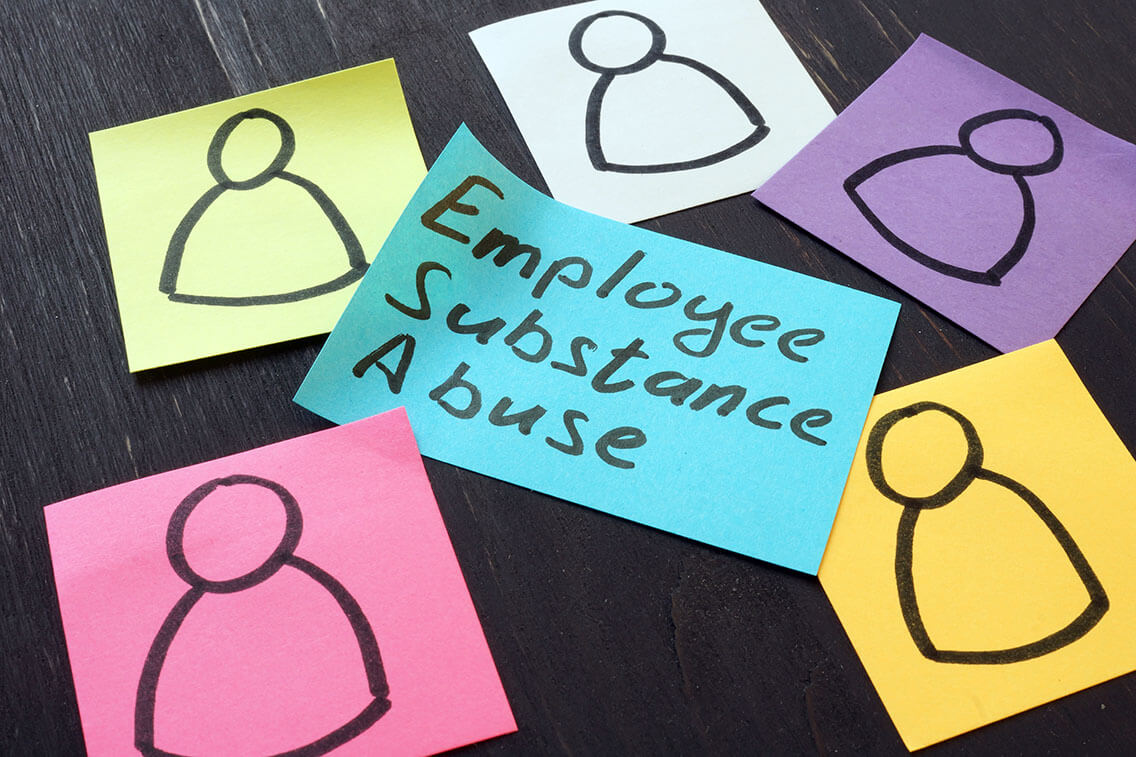Substance abuse in the United States is a serious problem that exists in workplaces of all types. According to the National Safety Council, almost 9% of working adults have a substance use disorder. That includes 6.7% of the workforce who have an alcohol use disorder and 1.6% who have a cannabis use disorder. Although the highest rates of substance use disorders are found in industries with younger, male-dominated workforces, such as construction, no industry is untouched by alcohol or drug abuse.
Substance abuse in the workplace is linked to a wide range of problems. While under the influence of drugs or alcohol, an employee can create stress for coworkers, cause a work-related accident, or damage property owned by either coworkers or the company.
Because of the serious impacts of substance abuse on the workplace, nearly any business can benefit from a solid substance abuse policy. It will help protect all employees and promote a safe and healthy work environment. While often voluntary, some businesses are legally required to institute a substance abuse policy due to the nature of their work.
Definition of Substance Abuse
Substance abuse means using any substance that can impair a person’s judgment, clarity, and functioning, whether on the job or in another area of life. Examples of substance abuse in workplace situations might include coming to work high or drunk, drinking or using illicit drugs on the job, or using any form of drugs or alcohol during breaks and lunch.
For most companies, substance abuse is defined as the use of illegal drugs or alcohol abuse. Yet some companies extend the definition to include legally obtained drugs too. These might include over-the-counter and prescription diet pills, pain medications, muscle relaxers, and opioids.
Signs of Employee Substance Abuse Problems
Substance abuse disorder (SUD) may be noticeable in the workplace by awareness of some telltale signs. If an employee exhibits a number of these, especially signs over time, further investigation may be warranted.
- Frequent absences
- Unexplained disappearances from the work site
- Unreliability in meeting deadlines
- Fluctuating job performance
- Increase in accidents
- Inattention or poor judgment that leads to mistakes
- Problems with coworkers
In addition to these signs, physical symptoms are an immediate sign of an employee using illegal drugs or drinking on the job. If an employee is observed at work with an unsteady walk, slurred speech, dilated pupils, or extremes in lethargy or hyperactivity, it may be necessary to take steps outlined in the employee handbook for the sake of safety.
Alcohol and Drug Policy in the Workplace

Many workplaces implement a substance abuse policy (or a drug-free workplace policy) to ensure that expectations are spelled out. A good substance abuse policy outlines the business’s rules, processes, and guidelines regarding the use of drugs and/or alcohol while on the job. This may include policies related to using, manufacturing, or distributing alcohol or illegal drugs in the workplace.
The substance abuse policy is often part of the employee handbook. The policy spells out how instances of substance abuse will be handled, drug testing requirements, and disciplinary action for a positive drug test or any other infractions of the rules.
Rules and Regulations Around Substance Abuse in the Workplace
A number of laws and regulations touch on alcohol and drug abuse in the workplace.
Employment Drug Test Laws
Several types of drug tests are permissible based on OSHA regulations, including random and pre-employment drug testing. In the event of an accident, employers are allowed to screen employees for drugs or alcohol as part of a post-incident assessment, according to OSHA, as long as the drug screening is not undertaken to discourage workers from reporting incidents.
ADA Accommodations
The Americans with Disabilities Act (ADA) also applies to employees with an identified substance use disorder, holding disabled individuals to the same standards when it comes to drug or alcohol usage in the workplace. The ADA allows drug testing and policies that prohibit the use of illicit drugs and alcohol on the job.
However, some recovering drug or alcohol-addicted employees are covered under special ADA rules. Employers must provide reasonable accommodations for workers with a substance use disorder who are in treatment programs or for workers who have recovered from addiction. ADA accommodations may take the form of job restructuring, part-time work or modified schedules, or a leave of absence to attend a drug or alcohol treatment meeting. This is one of the most important statutory requirements of the ADA.
Drug-Free Workplace Act

For businesses that have large federal contracts, the Drug-Free Workplace Act calls for a Drug-Free Workplace Program. A Drug-Free Workplace Program includes drug testing requirements as well as:
- workplace substance use education
- confidential screening and treatment referrals by employee assistance programs or health professionals
- confidential follow-up care for employees
- supervisor training
- clearly defined second or last-chance policies, return-to-work procedures, and safety procedures for employees prescribed opioids
Other Workplace Substance Abuse Regulations
Other substance abuse regulations may apply depending on the type of workplace or employment. Examples include:
- law enforcement positions
- airline employees, interstate motor carrier drivers, and railroad engineers governed by Department of Transportation regulations
- safety-sensitive jobs established by the Department of Defense and the Nuclear Regulatory Commission
How to Help a Worker with a Substance Abuse Problem
There are a number of ways that employers can help a worker who has a substance abuse disorder. Some ways to support workers include:
- Offer robust health insurance that helps manage prescription opioid use and requires prescribers to abide by CDC guidelines for prescribing.
- Offer SUD treatment coverage including screening to increase the rate of identification of risky or unhealthy drug/alcohol use.
- Offer supportive policies and programs (including return-to-work plans) for employees who took leave.
- Organize worker peer support programs to help workers who are dealing with job stress.
- Provide an employee assistance program (EAP) with 24/7 counseling access for all workers who might have common forms of mental illness or problems that interfere with work or home life.
Rehab and Recovery Programs
Once a worker acknowledges a substance abuse problem, one of their best options for successful treatment is a targeted recovery program. For employees in Michigan, Guiding Light’s drug and alcohol rehabilitation program offers an intensive option for rehab, long-term recovery, and relapse prevention. And it’s 100% free. According to Substance Use Disorders by Occupation–a report from the National Safety Council–employers who take the positive step of addressing employees’ substance abuse problems can considerably reduce costs related to turnover, absenteeism, and health care.
Supporting Workers Returning from a Rehabilitation Program
People who have experienced a substance use disorder and received professional help by attending a rehabilitation program can be model workers, especially in a supportive workplace environment. A supportive workplace can help prevent workplace factors that prolong a substance use disorder and lower barriers to receiving care. Supporting workers may include building awareness to reduce the stigma around substance abuse problems, and hosting health-focused and alcohol-free work social events.
Substance abuse in the workplace affects employee well-being, coworker safety, and the business’s bottom line. Managing substance abuse means developing policies that keep drug or alcohol use out of the workplace – a balancing act that is well worth the investment.


